
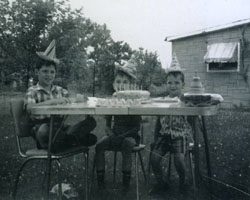

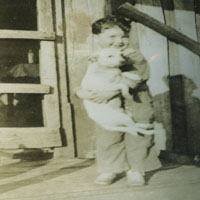

Mize family in the New World
JAMES MISE, MIZE, MICE
The children of James Mize are:
- JAMES MIZE (b. @ 1694-1698 Lunenburg Co Va; d. 7 Apr 1761 Lunenburg Co VA (m1) ELIZABETH NLN)
- JEREMIAH MIZE (b. 1698 Lunenburg Co VA; d. prior to 1796 Granville Co NC (m1) GRACE NLN d. @ 1732 (m2) TABITHA NLN)
- ROBERT MIZE (cm1)(b. @ 1721)
- JOSHUA MIZE (cm1)(b. 10 Mar 1726 Bristol Parish Prince George Co VA; d. 1790 Granville Co/Surry Co North Carolina (m1) PATTY “MARTHA” b. 1725 Madison Co KY; d. 1790 Wilkes Co NC)
- ISAAC MIZE (b. @1752; d. 1809 KY (m1) ELIZABETH TAYLOR)
- BENJAMEN MIZE (m1) KEZIAH CHAMBERS
- JEREMIAH MIZE (b. NC; d. 1823 Pulaski Co KY)
- Scenario 1
(m1) NANCY PARKS-PEEKS (d. before 1804 KY) - WILLIAM MIZE (b. @ 1792, father Jeremiah Mize)
- THOMAS MIZE (b. @ 1796, father Jeremiah Mize)
- ROBERT MIZE (father Jeremiah Mize)
- PEGGY MIZE (father Jeremiah Mize)
- JOSHUA MIZE (father Jeremiah Mize)
- Scenario 2
(m2) BETSY SLAUGHTER (possibly married on 1813 to Jeremiah Mize) (m3) ELIZABETH GILLILAND (possibly married to Jeremiah Mize but unlikely) (m2) ELIZABETH JACKSON BROWN (b. 1771 NC; d. 30 Sep 1856 Pulaski Co KY) - ISAAC MIZE (b. @ 1802-1805, fa)
- JOHN MIZE
- MARGARET MIZE (b. @1802)
- WILLIAM RILEY MIZE (b. March 1803 VA)
- ELIZABETH MIZE (b. @ 1806, )
- LUCY MIZE (b. @ 1816, consent of mother, Elizabeth Mize, to marriage)
- JOHNSON MIZE (consent of Elizabeth, kinship not stated on marriage bond)
- POLLY BROWN (child of Elizabeth Jackson Brown, step daughter)
- WILLIAM LIGUE BROWN (child of Elizabeth Jackson Brown, step son)
- JOHN MIZE (m1) NANCY BROWN
- LYDIA MIZE
- ELIZABETH MIZE (m1) NFN TAYLOR
- EDEY MIZE (m1) NFN CHAMBERS
- KISIAH (m1) NFN CHAMBERS
- NANCY MIZE (m1) NFN BROWN
- POLLY MIZE (m1) NFN ROBERTS
- JOHN MIZE (cm2)(1748 Tax List Mecklenburg Co VA; 1749, 1750, 1751, 1752 Lunenburg Co VA Tax List)
- HENRY MIZE (cm2)(1749, 1752 Tax List Lunenburg CO VA)
- HOWELL MIZE (cm2)
- JEREMIAH MIZE JR (cm2) (m1) MARTHA NLN m. 24 January 1791 Brunswick Co VA)
-
The children of Joshua Mize and Patty "Martha" Mize are:
The possible children of Jeremiah and Nancy are:
The possible children of Jeremiah and Elizabeth are:
The earliest records of the Mize family are from the south-central part of Virginia and north-central North Carolina. James Mize whose last name had more than one spelling such as Mice or Mise, was taxed in what was then Surry County, Virginia during the years 1694 and 1698. At that period of time, a Jeremiah was tithed to the local parish. Jeremiah was born about the year 1698 and was the son of the above James Mize. Jeremiah along with his brother James Mize lived on the Meherrin River. They were both granted land along Little Creek down to the river during 1728. Our line of lineage is derived from the brother of James, who is Jeremiah Mize.
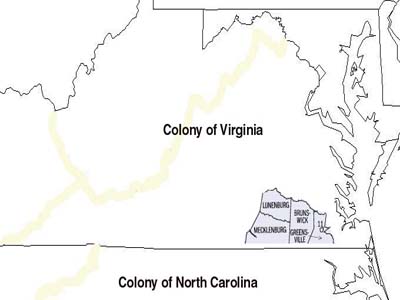
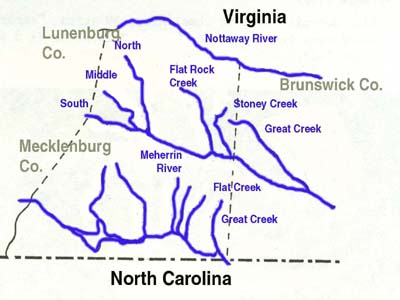
Jeremiah had 150 acres of land surveyed along both sides of Great Creek which is where the boundary of Brunswick
County and Lunenburg County join in Virginia. Later his first wife, Grace relinquished the dower for this land
on 9 May 1727. During a processioning which occurred on 14 July 1726, Jeremiah apparently moved to the confluence
of Stoney Creek and Meherrin River where the Brunswick County line crosses the river. He moved from Lunenburg County,
Virginia to North Carolina about the year 1750. He died in North Carolina about the same year, 1750. He had married
Grace who gave birth to Robert about 1721 and Joshua about 1726. Jeremiah later married Tabitha and gave birth to
John, Henry, Howell, Jeremiah Jr along with possible others. There is evidence of a grist mill called the Mize Mill
on the Meherrin River which was located near the present day Dix Bridge where the Mize raceway ran to the Mize ford.
Joshua Mize son of Jeremiah and Grace was born 1726 in Virginia. He is listed on the 1749, 1750, and the 1751 tithing records for Lunenburg County, Virginia but there are no records for Joshua after 1752. He probably moved to Granville County, North Carolina to be close to his brothers and father. The Granville District of North Carolina 1748-1762 by Margaret Hoffman page 233 cites that Lord Granville gives to Joshua Mize a land grant for 547 acres in Johnston County located on the north side of Little River on both sides of Julilies Branch on 12 September 1762. During the year 1783, he purchased 400 acres on Little Hunting Creek in Wilkes County which was located in the Yadkin Valley of North Carolina. This land cost Joshua 700 pounds. The land is located where Iredell, Yadkin and Wilkes counties adjunct near the present day town of Love Valley in Wilkes County. He purchased an additional 150 acres during November 1784 in the same region. He married a lady named Patty who was also known as Martha. There were three males over 21, five white females all ages and a 60 plus male listed in the household of Joshua for the 1787 tax list of Captain Gordon’s district of North Carolina. Joshua died during 1790 and he was the progenitor of the following children: Isaac who moved to Kentucky near present Irvine in Estill County; Benjamen who lived in Rowan County, North Carolina; Jeremiah, our lineage, who moved to Kentucky about the same time as his brother Isaac; John who lived in Wilkes County, North Carolina; Lydia; Elizabeth who married a man with the last name of Taylor; Edey who married a man with the last name of Chambers; Kisiah who also married a man with the last name of Chambers; Nancy who married a man with the last name of Brown; and Polly who married a man with the last name of Roberts.
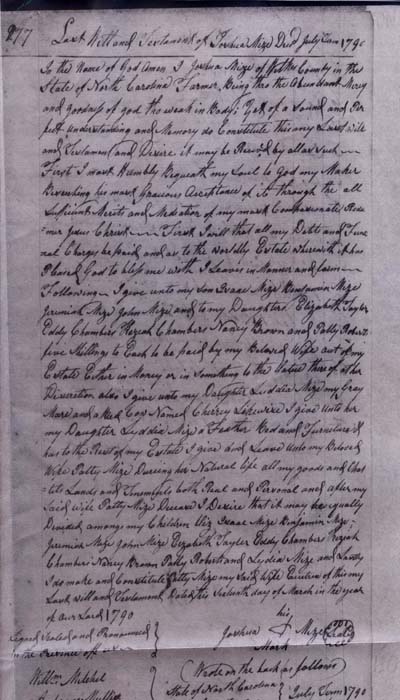
The above is the last will and testamony for Joshua Mize in North Carolina.
“The last will and testament of Joshua Mize dec’d July 1790. In the name of God Amen. I Joshua Mize of Wilkes County in the state of North Carolina, farmer, being — the abundant mercy and goodness of God, tho weak in body; yet of a sound and perfect understanding and memory do constitute this my last will and testament and desire it may be received by all as such
First I must humbly bequeath my soul to God my maker, besseching his gracious acceptance of it through the all sufficient merits and mediations of my —— compassionate redeemer Jesus Christ
First, I will that all my debts and funeral charges be paid and as to the Worldly estate wherewith it has pleased God to bless me with , I leave in manner and farm. Folloin , I give unto my son Isaac Mize, Benjamen Mize, Jeremiah Mize, John Mize, and to my daughter Elizabeth Taylor, Eddy Chambers, Keziah Chamber, Nancy Brown, and Polly Roberts five shillings to each to be paid by my beloved wife out of my estate. Either in money or in something to the value there of other discretion also I give unto my daughter Liddia Mize my gray mare and a red cow named cherry. Likewise I give to my daughter Lyddia Mize a feather bed and furniture. As to the rest of the estate, I give and leave unto my beloved wife Patty Mize during her natural life all my goods and —— lands and tenements both real and personal and after my said wife Patty decease I desire among my children that it may be equally divided among my children, Isaac Mize, Benjamen Mize, John Mize, Elizabeth Taylor, Eddy Chambers, Keziah Chambers, Nancy Brown, Polly Roberts, Lydia Mize and —- I do make and constitute Patty Mize my said wife, executrix of this my last will and testament dated this — day of March March in the year of our Lord 1790.”
Martha, Isaac’s wife, sold 150 acres of land for 5 pounds which was located on Hunting Creek and another 450 acres on the same waterway for 125 pounds during September 1797. This transaction called for a quit deed to be signed by family members to relinquish any rights for inheritance. It was noted that Isaac and Jeremiah were not living in North Carolina and Isaac sent a power of attorney for his signature concerning this.
Isaac the son of Joshua was born about 1752 in Virginia or North Carolina. It is difficult to state whether he was born in Virginia or North Carolina because of the disputed line boundary between the two states which was not settled until the late 19th century. Isaac’s first record is being a surety for bond concerning a marriage during 1781 in Surry County, North Carolina. The tax list of Surry County for 1781 notes that Isaac removed from the same county during 1781. He had traveled to Kentucky and taken up residence in Madison County between 1781 and 1786 and became a Lieutenant in 1788 for the Virginia Militia as Kentucky was still part of the Colony of Virginia at that period of time. Isaac is listed as having four horses and cattle during 1788 and one male over 21 years of age, 6 blacks under 16 years of age and 11 cattle in Madison County. Before dying in the Commonwealth of Kentucky, during the year 1809, Isaac fathered 12 children between the years 1776 and 1799 with his wife Elizabeth.
Jeremiah the brother of Isaac and the son of Joshua traveled from North Carolina to then Madison County, Kentucky during 1786. Trouble was always present by Indians who lived in the area. One such instance occurred during December 1786 when a body of Indians defeated a small party of pioneers at the mouth of Buck Creek not far from where Jeremiah had settled in the Sinking Valley area of present day Pulaski County. The Indians made their attack in the middle of the night, killed one man and severely wounded another. An Indian attacked the leader of the pioneers with a tomahawk but was fought off successfully. Another party of Indians stole horses near Crab Orchard during May 1788. Lieutenant Nathan McClure along with a portion of his command pursued the Indians to the ridge between Rockcastle River and Buck Creek. They met another Indian party and a melee ensued. Both parties fired at each other and subsequently McClure was mortally wounded with several of his party also being wounded. Consequently both parties disengaged and retreated into the woods. McClure died during the night in a cave where he insisted upon being left at. The next day a group of militia was led back to the cave only to find that he had been mangled and eaten by wild beasts.
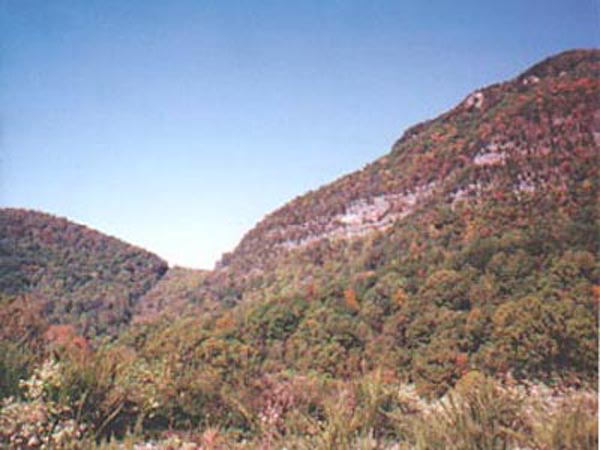
This is Cumberland Gap which is located in southeastern Kentucky where all travelers would pass through following the Wilderness Trail.
(picture retrieved on 15 April 2008 from http://www.geocities.com/gentutor/cumberlandgap.html)
 Jeremiah was certainly exposed to such conditions and to attacks by the Cherokee and Shawnee Indians which lived on both sides
of the nearby Cumberland River which was called “The Land of the Hummingbird.” Three of the most holy sites for the Chicamauga
Cherokee are located in present day McCreary County just south of Pulaski County. Cumberland Falls, Yahoo Falls and Eagle Falls
form the sacred triangle. A note of interest is the massacre of Indians at Yahoo Falls that occurred at the beginning of the 1800s.
Skaggs Trace, near Skeggs Creek, was an off shoot of the Wilderness Trail. It ran from where present day London, Kentucky is located
and it provided access to northern Kentucky via Crab Orchard. Skaggs Trace was much more traveled than the famous Wilderness Trail
and was a much more strenuous and extremely hazardous route through western Rockcastle and eastern Pulaski counties. This is evident
because over 100 pioneers immigrating through the Kentucky side of the Cumberland Gap via the Wilderness Trail were killed by renegade
Indians during the year 1784; just a couple of years before Jeremiah and his brother Isaac traveled from North Carolina to pre-commonwealth
Kentucky.
Jeremiah was certainly exposed to such conditions and to attacks by the Cherokee and Shawnee Indians which lived on both sides
of the nearby Cumberland River which was called “The Land of the Hummingbird.” Three of the most holy sites for the Chicamauga
Cherokee are located in present day McCreary County just south of Pulaski County. Cumberland Falls, Yahoo Falls and Eagle Falls
form the sacred triangle. A note of interest is the massacre of Indians at Yahoo Falls that occurred at the beginning of the 1800s.
Skaggs Trace, near Skeggs Creek, was an off shoot of the Wilderness Trail. It ran from where present day London, Kentucky is located
and it provided access to northern Kentucky via Crab Orchard. Skaggs Trace was much more traveled than the famous Wilderness Trail
and was a much more strenuous and extremely hazardous route through western Rockcastle and eastern Pulaski counties. This is evident
because over 100 pioneers immigrating through the Kentucky side of the Cumberland Gap via the Wilderness Trail were killed by renegade
Indians during the year 1784; just a couple of years before Jeremiah and his brother Isaac traveled from North Carolina to pre-commonwealth
Kentucky.
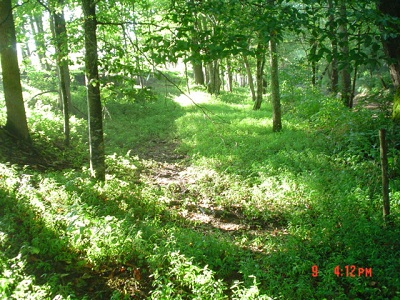
.jpg)
This is a sidebar to the Jeremiah travels which probably took him along the Skaggs Trace through Rockcastle County. I was visiting Everett Renner who lives
on Steep Hollow Road during which he told me that part of Skaggs Trace ran along his property beside Skaggs Creek. He graciously welcomed me to take a
walk down by the creek to see the remains of the the track. Once we were there, Everett told me that he allows the cows to eat the vegetation on the trace which
gives it a nice kept up appearance. He also stated that historians had verified that this was part of the Skaggs Trace and one of the few that is clearly
visible within the area. If you look at the right hand side in some of the photos, you can see the rock filled Skaggs Creek where settlers no doubt took refreshment from during
their travels on this passageway. The photos are taken looking down Skaggs Creek and up Skaggs Trace. Thanks Everett for the great experience! Back to the story....
.jpg)
.jpg)
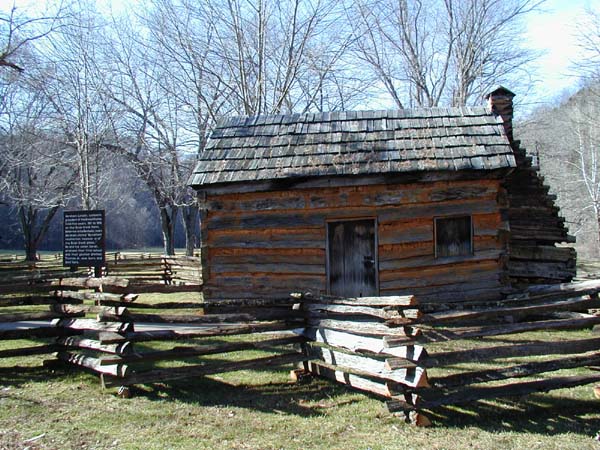
Picture of a typical log cabin which would have been built by Jeremiah or Isaac Mize after arriving to western Virginia (present day Kentucky)
(retrieved on 1 April 2008 from http://www.parktrust.org/projects/lincoln/cabin01.jpg)
Isaac and Jeremiah were both listed on the 1789 census of the then Madison County, Kentucky. Jeremiah did not travel back to North Carolina to
sign the quit deed for his mother during 1790, nor did he send a power of attorney as did his brother. Life was not easy for Jeremiah Mize
when he finally arrived in the Sinking Valley area in present day eastern Pulaski County. His days were filled with toil and never ending
vigilance for sustenance and danger. This is best told by selections from the book Pioneer Life in Early Pulaski County, A history of Pulaski
County, Kentucky compiled by Alma Owens Tibbals (Baghdad, Kentucky: published by Grace Moore 1952.) “The first concern of the people was
to establish homes. They made clearings, felled trees, hewed logs and built one-room cabins. As time went by they added another room, leaving
a space between them called the ‘dog-trot,’ through the breezeway probably would have been more applicable. It was used as a shelter for sheep
whose flesh was so necessary for meat and whose wool provided clothing. Wild animals abounded. Bear, deer and wild turkey were all used for
meat, their skins for clothing, and feathers for clothing and bedding. There was wood a plenty for the huge fireplace, which was long enough
for the children to stand in and keep warm without crowding the family circles. The baby was rocked in a hollowed-out log, with one end left
open for the warmth from the fire to keep the little one warm. The older children slept in the trundle bed. To conserve room, the quilting
frames were attached to pulleys and drawn up to the ceiling when not in use. The women performed the household duties, the men cleared and
cultivated the land and hunted the game to supply the family with meat. Every family raised flax from which their linen was mane, and every
farm had its patch of cotton which was carded and spun into cloth. The spinning wheel whirred and the loom creaked day and night. Sewing was
all done by hand and with homespun thread. It was not until after the Civil War that the first sewing machine was brought into the country…
It was late, too, before the first cook stove, hauled from Louisville (no date), attracted the curious who gathered to see it ‘blow up’ when
the first fire was built in it. Food had to be stored for winter use, as there were no fruit jars for canning, no frozen food lockers, no
home deep-freezers, no trucks bringing fresh fruits and vegetables, Cabbage, turnips and potatoes were buried, apples, beans, and pumpkin
which was cut in circles and placed on sticks, rested on rafters for drying. In addition there were eggs, butter, and famous Kentucky corn
bread baked in an iron oven on the hearthstones. Although limited in variety the food of the pioneers was wholesome and nutritious. Upon
this diet they thrived, being stalwart, robust, and long lived men. One man, Elijah Denny, a Revolutionary soldier, was 115 years old in 1855
and still active, working on his farm. He drank only one cup of coffee in his lifetime and that was late in 1848. A strict member of the Baptist
Church, he rode six miles to every service. His grave is on the county line between Pulaski and Rockcastle (counties.) One of the most urgent
needs of the settlers was slat. Before they could produce it themselves, men rode horseback or in crude wagons to Middlesboro, a distance of 75
miles and brought back enough to last a community for week or perhaps months. They often rode a great distance to the gristmill to have their
corn ground. Their soap was made from the entrails of hogs. These they cleaned and dried when the hog was butchered and then boiled in lye to
produce a strong soft soap.” This is a very brief insight into the daily rigors which a typical family would experience during colonial pioneer times.
There is some debate about Jeremiah’s family lineage. There are two possible scenarios that may have occurred concerning who Jeremiah had married and who his progeny may have been. The first scenario would have Jeremiah’s wife dying and leaving five children for him to take care of alone. According to courthouse records, Jeremiah married Nancy Peek or Parks on 22 July 1790 in Madison County, Kentucky. After their marriage, Jeremiah purchased 100 acres of land in eastern Pulaski County's Sinking Valley on the date 18 July 1799. Jeremiah is listed on the Madison County, Kentucky Tax List for the year 1800. He is later listed on the Pulaski County, Kentucky Tax List for the years 1801 and 1803 while living on a 100 acres Land Grant on Pitman Creek in Sinking Valley. Sometime before 1804, his wife died and their children were bound out to other families between the years 1804 to 1805. Robert was bound out during August 1804 to Richard Beason to “learn the art and mysteries of a farmer’s business and have him taught to read.” Thomas was bound out to John Gibson of Pulaski County on 26 November 1804 until he was 21 years old to learn the trade of Blacksmithing. He is stated as being twelve years old which would indicate that he was born about 1792. William was to learn the trade of a hatter in the residence of William Fears until he was 21 years old. The court order states, "is honestly and industriously to serve and obey William Tears (Fears) in all lawful commands until he shall be 21 years old, and he the said William Fears doth covenent and agree to find the said William Mize, a sufficiency of good clothes and also a sufficiency of good wholesome diet and all other necessities so long as he shall serve him and to learn him the..all the common acts and mysteries of the the hatters have and to have him taught to read and write and common arithmetic including the rule of thumb and treat him in an humane and tender manner in all things and at the expiration of..service. to give him three pounds and ten shillings and a decent new suit of clothes..." William is bound out on 28 May 1804 and he is 12 years old. He was born about 1792. William Fears had married Susannah White on 14 March 1800 in Pulaski County, and the sureties were Richard Price and NFN Hansford Peggy was bound out on 24 June 1805 to James Hardgrove was to keep house and "weave" until she was 18 years old. Joshua was bound out during July 1804 to be a farmer until the age of 21 at the residence of James Hardgrove. All the families which the children were bound out to lived in Pulaski County, Kentucky. Peggy or Margaret Mize was married with the consent of her father, Jeremiah to Moses Pitman on 21 July 1819 in Pulaski County. The typical order which bound out these children states that they must be given sufficient clothing, a good diet and other necessaries until they reach 18 years of age. At the end of their service to the families, each child was to be given 3 pounds and 10 shillings.
A second scenario occurs when Jeremiah married Betsy Slaughter on the date 6 August 1813 with Charles Dodson as Surety in Pulaski County, Kentucky. He is listed again on the Pulaski County Tax Lists for the years 1813, 1817, 1818, 1820, and 1822. But a stumbling block appears because he leaves all his earthly possession to his wife "Elizabeth" in his will which was probated on 1 September 1823 in the same county. The name Betsy is easily translated to Elizabeth during this time and the 1823 taxes were paid by a "Betsey" Mize. Betsy Slaughter is difficult to substantiate as a true wife of Jeremiah because of the birth years for children born between 1805 and 1813. I feel that evidence points to Jeremiah's marriage to Elizabeth Jackson Brown who is believed to be a widow and the daughter of Mark Jackson. She was born in North Carolina during 1771 and later died on 30 September 1856 within Pulaski County, Kentucky. She was 86 years old and lived in the Aaron Price household in eastern Pulaski County. Elizabeth Jackson Brown had at least two children from a previous marriage to an unknown Brown. The marriage between Jeremiah and Elizabeth Brown is validated by the marriage bond for her daughter, Polly Brown, to Aaron Price. Polly married Aaron Price on 1 Jan 1816 in Pulaski County, and on the bond appears "Jeremiah Mize, husband of Elizabeth Mize, mother of Polly." The sibling of Polly, William Ligue Brown is confirmed by the Will of her father, Mark Jackson, dated 24 Nov 1806 (Pulaski County Will Book 1, page 26.) The will states that Mark Jackson leaves "my son Jeremiah Jackson, estate I have being in Prince Edward County, Virginia...My grandson William Ligue Brown, who was bound to me by the court of Pulaski County, Kentucky. shall be bound to my son Jeremiah Jackson. I will to my beloved daughter, Mary Magaline McFarding, one dollar. I will to my beloved daughter, Elizabeth Brown, one dollar."
Considering this scenario, Jeremiah Mize would had step children included into his growing family. In addition to Polly Brown,
there are other possible children of Jeremiah and Elizabeth Jackson Brown. These children are: Isaac "Ike" from whom we are descendent.
Margaret who was born about 1802 and married on 21 June 1819 to Moses Pitman. Margaret is the same daughter "Polly" in the first scenario;
Elizabeth who was born about 1806 and married James Hansford on 1 January 1826 in Pulaski County. Elizabeth's mother, Elizabeth signed for
her to marry and William R. Mize was listed as the surety.
Johnson Mize was possibly shortened to John later in his life and his mother is listed as Elizabeth. He married Elizabeth Evans on 21 Mar 1836 in Pulaski County. William R. Mize is listed as the
principle and consent is given by her father, Alexander Evans and Elizabeth Mize. He later moves to Kansas.
Lucy was born about 1816 and she married Owen Hunt on 6 February 1836 in Pulaski County with the consent of her mother Elizabeth and William R. Mize was
listed as the surety.
John Mize who was about the same age as Isaac and William Riley and lived in dwelling number 16 which was near Isaac and William Riley.
John was granted 50 acres of land on Buck Creek, in Pulaski County, Kentucky and during 1838 he sold land to Walker Hansford. He is listed in the
1830 census of Pulaski County with the following family: 1 male 20-30 years old, 1 female under 5 years old, no other female. He appears to be
a widower but later marries Ann Murphy on 6 December 1831 in the same county.
I do believe that William Riley is related to our Mize
family due to the fact that he is present for the marriage between Isaac Mize and Polly Lucor during 1823 even though he is
listed as being born in Virginia. William Riley was born during March 1803 and he is buried at Short Creek Cemetery near Stab, Pulaski County,
Kentucky. He married Hannah Evans on
21 December 1823. Somehow William Riley is indirectly or related to Jeremiah Mize. There is a family story that William Riley
Mize's father had the last name Doolin and Elizabeth's last name was then changed to Doolin. Elizabeth's maiden name had been Gilliland and when
she married Jeremiah, her last name became Mize and thus William Riley "Doolin" became William Riley "Mize." This is all conjecture by family descendants.
On the 1850 Census of Pulaski County, Isaac, William Riley and John all lived in the same general area of eastern Pulaski County. Isaac purchased
land on Line Creek in Pulaski County and John purchased 132 acres in Pulaski County on 4 May 1825.
I feel that the second scenario is the correct fit for our Jeremiah. This would lend to the fact that Isaac, who we descend from is accounted for
because William Riley Mize is present for the marriage between Isaac and Polly Lucor during 1823.
Inevitably Jeremiah left a last will and testimony which is located at the Pulaski County Courthouse. The will states:
“Know all men that I Jeremiah being now in my proper senses and well composed in mind and calling to mind the mortality of the body and that I must
shortly go home, do this day make this as my last will and testament, wherein I bequeath to my true and trusty wife Elizabeth all the estate that I am
now in possession of namely one boy mare, two cows, four calves, fourteen head of hog , together with all my house hold and kitchen furniture and farming utensils.
Also my percent of crop for her to have and to hold forever after my decease to use at her discretion. Signed September 1 1823”
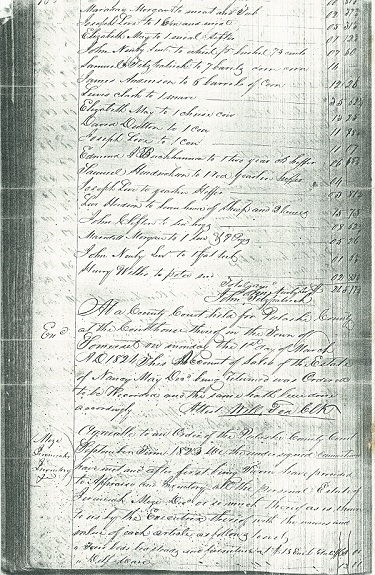
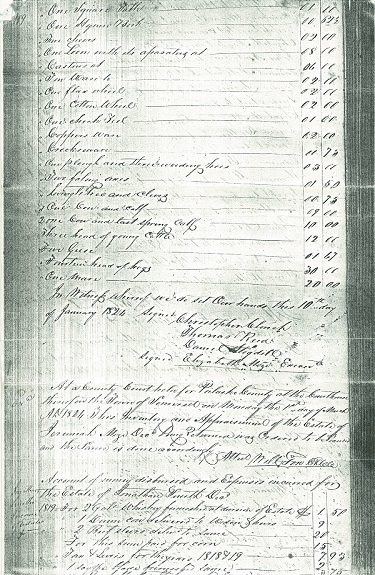
Another court order pertaining to the disposition of Jeremiah’s personal estate inventory which is located at the Pulaski County, Kentucky courthouse.
It states; “ Agreeable to an order of the Pulaski County Court September —- 1823, we the undersigned —- have met and after first being sworn have proceeded
to appraise and inventory all the personal estate of Jeremiah Mize dec’d or so much there of as is shown to us by the executrix thereof with the —- and —-
of each article as following —-: four beds —-and furniture, $15 each bed for $60; Delf ware $13; One square table $1; one book 62 1/2 cent; five chairs $2;
one loom with its apparatises $8 ; castirons $6; tinware $2; one flax wheel $2; one cotton wheel $2; one card reel $1; copperware $2; crockware 75 cents;
one plow and three weeding hoes $3; two felling axes $1.50; —- tree and —-75 cents; one cow and calf $9; one cow and last spring calf $10; three head of
young cattle $12; five geese $1.67; fourteen head of hogs $30.; one mare $20; In witness whereof we do set our hands this 10th day of January 1824”
(retrieved on 15 May 2012 from http://www.jeffrenner.net/genealogy/photos_pricevalleycemetery.htm)
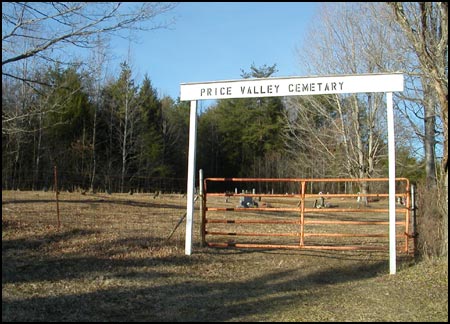
Where Jeremiah is buried is not known but I feel assured that he is buried somewhere in the Mount Pleasant Church area located in the Sinking Valley
watercourse in eastern Pulaski County. In addition to this assumption is the greater possibility of Jeremiah being buried in the Price Valley Cemetery.
Jeremiah’s wife, Elizabeth, is buried at the same cemetery. She was living in the Aaron Price household when she died. Elizabeth’s daughter, "Polly",
Mary Brown,
had married Aaron Price, who was born in Virginia 1789 and died around 1870. Isaac, his father
Jeremiah, and William
Riley Mize worked on the Aaron Price property located within the Sinking Valley area in Pulaski County. The photo was taken at the Price Valley Cemetery
which is located on the north side of Highway 80 near Line Creek in Pulaski Co, Kentucky.